 “Are we there yet?” The small voices rise from beneath the heavy blankets that keep the children warm on this journey. It’s been months of grueling travel through inhospitable land, the promise of reaching the fabled uninhabited Boonlake seeming more like a tall tale with each passing day. How did this rumor emerge? Did someone find it and run to gather others? Would we be the first?
“Are we there yet?” The small voices rise from beneath the heavy blankets that keep the children warm on this journey. It’s been months of grueling travel through inhospitable land, the promise of reaching the fabled uninhabited Boonlake seeming more like a tall tale with each passing day. How did this rumor emerge? Did someone find it and run to gather others? Would we be the first?
The wagons reach the rise of a grassy hillside, and our eyes are temporarily blinded by the sun reflecting off a brilliant blue snaking river that cuts through the terrain. A vista slowly materializes and the rumors shift from baseless fantasy to an exhilarating truth. The fabled land of Boonlake is before us. It is real. You turn to the children peering from behind your shoulder, their excitement as palpable as your own. Then the smallest asks, “Where’s the lake?”
Boonlake is an action-selection euro strategy game from designer Alexander Pfister and publisher Capstone Games. One to four players can join in the hard work of inhabiting this new world in sessions that last approximately 90-120 minutes.
Gameplay Overview:
The main board of Boonlake features four regions with hex spaces that are improved upon over time. These regions are split by a river that each player’s ship traverses. The river is effectively the game’s timer. When the first ship crosses a blue dam along the path, this triggers an interim scoring phase. There are two scoring phases in the first round, after which ships reset back to the beginning of the river and traverse the path again down a new branching path. After the fourth interim scoring phases, the game ends once all players have taken an equal number of turns.
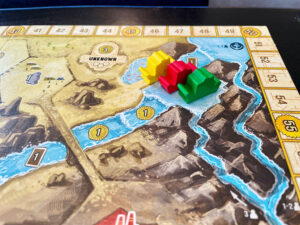
Players start with their own player boards that feature inhabitants (workers), houses, settlements, and cattle. These pieces shift from player boards out onto the main game board during play, which reveal income bonuses received during interim scoring. The more presence a player has on the mainboard, the more points and coins they receive for the next phase.
Player boards also feature a boat track (different from the ships) that manages the virtual resources available—wood, gems, stone, and metal. Players choose a bonus resource to start with and move their two boats downstream (for free) or upstream (for a cost) during play to “gather” the necessary resources required to pay for project cards from their hand.
The heart of Boonlake lies in its innovative action selection system. There are seven total action tiles displayed vertically on the action board. On a player’s turn, they choose which of the seven tiles to activate by pulling it off the board, taking the action, then returning it to the bottom of the board and sliding the tiles up. The location of the tile determines how many spaces their ship moves at the end of the turn. The higher up the tile is, the more spaces a ship moves. The lower the tile the smaller number of ship movement, as well as a points penalty in the bottom two spaces.
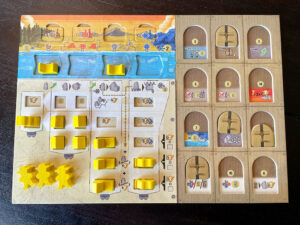
Six of the action tiles provide the opportunity to play a project card of a certain suit. Project cards are either day-, evening-, or night-specific and may only be played when triggered by the appropriate tile. Cards may afford an immediate benefit, an ongoing bonus, or end game scoring. Each action tile also has an action specific to the current player, as well as an action for all players at the table. As such, selecting a tile may benefit an opponent’s situation during your turn.
Some actions allow players to add new hex tiles to the mainboard, upgrade inhabitant-to-house or house-to-settlement, play or draw cards, or gain new inhabitants into their ranch. There is a tile that allows players to modernize their player board with levers that provide once per phase bonus actions at a cost. And there is a tile that brings income for presence that players have on the mainboard.
Through these actions players begin to build said presence, move their ship along the river, carefully maintain their ranch of inhabitants, and cultivate modernizations to improve their engine. Cards also provide options to move up the coin and card tracks which in turn provide better income during scoring phases.
During these scoring phases, players are challenged with meeting the goals of one of the four scoring tiles that are pre-selected at the start of the game. The scoring tiles are easy to complete in the first phase, but their requirements ramp up and become harder to achieve over time. They provide bonus points for completion but penalize those who are unable to complete them. As such, scoring tiles provide a pathway for progress for those looking to meet the goals of this new territory.
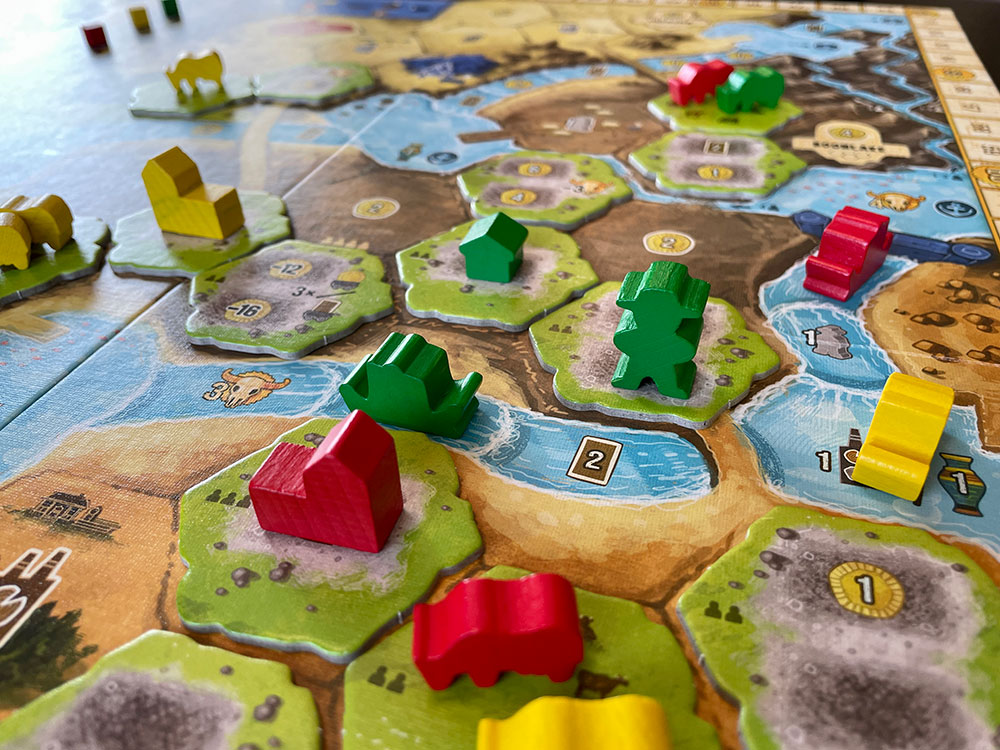
Game Experience:
Boonlake is a confusing game to discuss, as it takes disparate elements from two of Pfister’s earlier games, Maracaibo (2019, hand management and ship movement) and Oh My Goods! (2015, day/night card suits), as well as area control elements from Terra Mystica (2012), stacks an exciting set of ideas on top, and then gives up by attaching a tired theme. But more on this later.
The star of the show here is the action selection. Each turn you’re faced with deciding which tile provides the most benefit to your engine, considering the bonus your opponents will receive, while also gauging how far you want your ship to travel. That’s a lot to consider, but the game’s design assists by providing better bonuses the further you travel down the river. As such, taking a tile that’s been sitting at the top of the queue may not be as exciting, but the bonus you get along the river may be just what you need for the next turn.
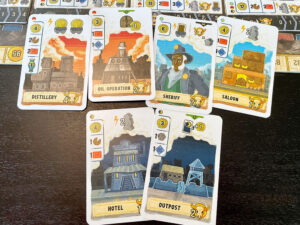
The shared experience of each action is not new but may be one of the thematic elements that works here. Everyone is trying to inhabit the land of Boonlake, so it makes sense that when you modernize your player board, for example, others get the opportunity to as well (at a cost). There are also bonuses for sharing cattle space with others, as well as building houses and settlements in ways that provide increased presence.
The project card day/evening/night suit system increases the action selection system intrigue. If you have an excellent night card in hand, to play this you must seek out an action tile that will allow it to be played. Thus, hand management becomes a powerful piece of successfully navigating a turn. And while you’d think there would be an issue with random card draw, there are many ways to draw cards so that there’s always a possible option in hand.
The other two areas that shine are the virtual production and modernization options. Throughout play, there are opportunities to increase the number of resources available to you. The more resources, the better cards that can be purchased. And resources never run out, though on occasion you must shift your boats along the stream (sometimes at a cost) to get the correct resources lined up. Modernization is also important as it provides bonus actions that will boost players’ engines. Each space has a cost, but players ultimately have the freedom to choose their modernization path, and getting this up and running early is important for efficiency.
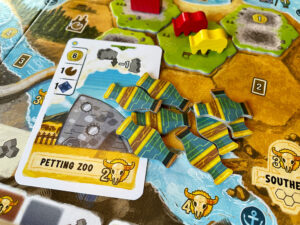
Back to theme. Boonlake could’ve been about anything. There’s not even really a central lake featured in the game, though the box cover suggests otherwise. Instead, it’s just an uninhabited land ripe for the taking. But what if I told you the game also features circuitry in the artwork? Or how about the fact that the lone acquirable resource is a colorful vase? What do these represent exactly? And while the artwork is cohesive overall and evokes an old west theme, it harkens to stories already told and runs counter to the new ideas on display. All of this is a missed opportunity and comes across as halfhearted.
One final piece to mention is the fact that the current ruleset does not provide enough incentive to push hard down the river. Due to this, gameplay can linger too long, and players may find that they are able to complete most goals during the game. An officially sanctioned variant exists that adds +1 base movement to ships, thus allowing players to push a little harder down the river. I recommend adding this from the start as it will provide much needed tension and prevent the game from overstaying its welcome. Without this option available, players would be able to see most of what Boonlake has to offer in only a couple of plays.
Final Thoughts:
Pfister struggles here with the balance between mechanism and theme. He’s taken an innovative efficiency engine and instead of providing a new world to explore, he’s given us yet another batch of worker meeples, settlements, and cattle. And while the game is fun to play, especially at the three-player count, it doesn’t shine above any of its influences. Add to this the fact that Boonlake can’t quite figure out exactly what it wants to be thematically (despite playful art from veteran Klemens Franz), and you must wonder if the new inhabitants to this land will be as excited by their discovery after a few generations have passed. I recommend Boonlake to those who’ve not yet played any of the influences on its design, as there is plenty to enjoy here. But for those who’ve already discovered them, perhaps it’s time to get into our wagons and return to more familiar and refined destinations.
Final Score: 3.5 stars – Several innovative ideas fighting to stay afloat in a lake of confusing theme and missed opportunities.
 Hits:
Hits:
• Excellent action selection
• Modernization levers
• Virtual resource production
• Charming card artwork
Misses:
• Confusing thematic elements
• Not enough tension
• Muddled iconography
• Scoring tiles not impactful






















